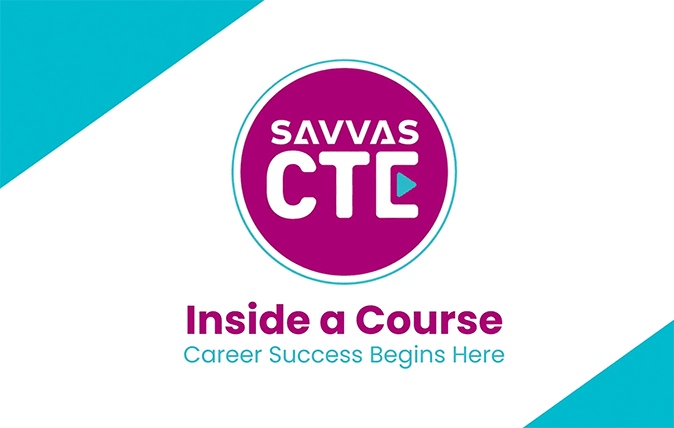Florida Introduction to the Teaching Profession Course
In Florida Introduction to the Teaching Profession, students will:
- Learn about the code of conduct for educational professionals
- Explore career opportunities and paths to leadership in education
- Discover strategies for managing inclusive and diverse classrooms

Florida Introduction to the Teaching Profession Course
Prepare Florida students to apply professional teaching best practices to educational careers.

Student-Centered Design
Based on decades of educational research, each course is designed to maximize student learning, motivation, and achievement. Utilize pedagogical concepts such as Understanding by Design, Growth Mindset, and Video and Project-based Learning.
Interactive Learning
Engage students every step of the way with relevant content, interactives, videos, discussion boards, text-to-speech, language translations, projects, and more. It’s a learning experience students love.
Ready for the Real World
Students become career ready when they go beyond understanding concepts to applying them in real life. Through practical activities, students gain the skills they need for in-demand careers.
Equip Florida students with teaching best practices
-
Course Outline
-
Module Introduction
-
Interactive Instructional Design
-
Formative and Summative Assessments
-
Teacher Resources
-
Accessibility
Teaching as a Profession Course Outline by Module
-
- Module 1: Career Skills and Opportunities in Education
- Module 2: Professionalism in an Education Setting
- Module 3: The Components of Diversity
- Module 4: Professional Code of Conduct
- Module 5: Historical Foundations of Education
- Module 6: Employment Practices
- Module 7: Teamwork
- Module 8: Leadership and CTSO Opportunities
Module Introduction
-
Module Introduction Video and DescriptionEach module begins with an introductory video where the instructor sets the stage for topics and learning objectives for the upcoming module. The video is followed by a short description of the module content.
-
Module Learning ObjectivesEach module introduction includes the set of learning objectives for students to review prior to beginning instruction.
-
Polling QuestionStudents engage with an interactive poll related to the upcoming module content. After completing the poll, students can see how their peers responded with a percentage breakdown of the results.
-
Introduce New VocabularyThe module introduction concludes with an interactive vocabulary matching activity, designed to familiarize students with words and concepts they will learn in the upcoming module.
Interactive Instructional Design
-
Career-Ready PracticeEach course begins with digital worksheets that guide students through real-world reflections, writing, and decision-making to help them build the professional skills needed to start their careers.
-
Engaging Lesson VideosEach lesson begins with an instructional video from an expert educator, designed to grab students’ attention while addressing learning objectives.
-
Interactive ReadingEach lesson video is followed by an interactive reading where students dive into new material with embedded interactives like hot spots, flip cards, slides, videos, and more!
-
Integrated ActivitiesActivities are embedded purposefully between lessons and incorporate a variety of interactive tools for students to practice what they’ve learned.
-
Project-Based Learning
Module Projects
Integrated throughout each course, module projects are smaller, skill-specific assignments that reinforce the concepts tied directly to each module’s objectives.End-of-Course Project: Culminating Project-Based Learning Experience
This is a comprehensive, real-world project that brings together everything students have learned throughout the course. It challenges them to apply multiple skills in an authentic context and results in a final product that demonstrates career readiness—often suitable for portfolios.
Formative and Summative Assessments
-
Concept CheckEmbedded concept checks include a variety of low-stakes activities, including short answer responses, matching, flashcards, and sorting.
-
Discussion-based ReflectionsThought-provoking discussion prompts invite students to process and share their learning with their peers. Utilize your LMS discussion board or have students work in an individual course journal.
-
Short Answer AssignmentsShort answer assignments are included at the end of each module, providing an opportunity for students to analyze and apply their learning to a real-world situation. Students are supplied with a detailed assignment rubric, with clear expectations.
-
Module QuizzesEach module concludes with a quiz, assessing student understanding. Quizzes are auto-scored and the results report back to the teacher’s gradebook in their LMS.
-
Midterm ExamAssess student content mastery midway through the course.
-
Final ExamA comprehensive final exam assesses student skills and knowledge at the end of the course. The final exam is auto-scored and the results report back to the teacher’s gradebook in their LMS.
Teacher Resources
-
Standards and CorrelationsEach module maps directly to Florida’s CTE standards—including technical, academic, and employability skills—to help justify curriculum alignment for adoption.
-
Pacing GuideGives teachers a clear plan for assigning coursework and managing time each week to complete the course within a semester or year-long timeframe.
-
Blended Learning GuideSupports teachers in mixing modalities—like station rotation or flipped classrooms—to create flexible, engaging lessons tailored to student needs.
-
Answer Keys & RubricsAlternative activities are embedded throughout lessons to meet accessibility standards and provide alternatives to the interactive activities in multiple choice format.
-
Technical Support DocumentsQuick-reference guides that answer common tech questions—like how to log in, sync grades, and navigate the platform smoothly.
Accessibility
-
Text-to-SpeechAudio features allow greater accessibility for students. Highlight any text within the course to have it read out loud, including image alt text.
-
Language TranslationsTranslate any text within the course, including video transcripts, into 60+ languages. Additionally, many language translations can be read out loud using the text-to-speech feature.
-
Closed CaptioningAll videos within the course include closed captioning with the ability to access video transcripts and translate into 60+ languages.
-
Alternative ActivitiesAlternative activities are embedded throughout lessons to meet accessibility standards and provide alternatives to the interactive activities in multiple choice format.
Explore Florida Introduction to the Teaching Profession content to promote learning
Course Preview
Get a sneak peek into the Florida Introduction to the Teaching Profession course, featuring key learning highlights.

Digital Tour
Experience the engaging instructional design and learn about system integrations.
Flexible System Integrations for Your Teaching as a Profession CTE Program
Seamless Integration With Your LMS
Whether you’re launching in one classroom or across a district, enjoy turnkey access on your favorite LMS through the award-winning Savvas Realize platform.
Additional Florida Introduction to the Teaching Profession Resources
-
Blended Learning Guide
-
Pacing Guide
-
Answer Keys
-
Course Syllabus
-
On-Demand Training
Blended Learning Guide
Provides teachers with robust support for planning and implementing the course in a traditional classroom, including best practices for blending face-to-face and online learning activities.
- Step-by-step teaching support for each lesson
- In-class discussion prompts
- Suggestions for independent, small group, and whole class instruction
- Facilitation support and student work samples for projects
- Sample student responses for reflections and short answer assignments
Request more information

Pacing Guide
Provides a tool for teachers to appropriately assign coursework and allocate time on a weekly basis for completing a course within a semester or year long time frame.

Answer Keys
Includes answers and grading rubrics for Reflections and Short Answer Assignments, along with detailed grading rubrics and sample student work for Projects.

Course Syllabus
The syllabus includes a high-level course overview, module overviews, and module learning objectives.

On-Demand Training

Frequently asked questions about Florida Introduction to the Teaching Profession
-
What modules are covered in this course?
- Module 1: Career Skills and Opportunities in Education
- Module 2: Professionalism in an Education Setting
- Module 3: The Components of Diversity
- Module 4: Professional Code of Conduct
- Module 5: Historical Foundations of Education
- Module 6: Employment Practices
- Module 7: Teamwork
- Module 8: Leadership and CTSO Opportunities
-
What grade levels is this text appropriate for?Grades 9–12
-
What types of programs is this course designed for?This program is designed for CTE Child Development pathways or elective offerings.
-
Is this program available in print or digitally?Florida Introduction to the Teaching Profession is a robust, digital-only course ideal for virtual or blended learning.
-
What teacher resources are available?Teacher resources include the course syllabus, pacing guide, answer keys, blended learning guide, and digital courseware access. Additionally, an on-demand, self-paced teacher training course covers the fundamentals of implementing the curriculum.
-
Which Learning Management System (LMS) does this course integrate with?Digital courseware is delivered by LTI integration with the following Learning Management Systems: Savvas Realize®, Canvas®, Schoology®, Blackboard®, Moodle®, AGILIX® Buzz®, D2L or Focalpoint.
-
What are the digital license options?Student digital access to Florida Introduction to the Teaching Profession can be purchased for 1 year.
-
How long does it take to complete the course?Teaching as a Profession is designed to support a full-credit course and therefore may be used to support a semester- or year-long option. On average, this course requires 80 instructional seat-time hours, equating to roughly 3–4 lessons per week. Teachers can make course customizations if desired to meet specific needs.
Prepare your students for college and career success. All with one solution.
Whether you want to empower your students to explore potential careers, prepare for college, or become certified professionals, it’s easy to do it all with Savvas PathMaker. Simply mix and match dual enrollment courses and CTE courses from our comprehensive catalog to create personalized pathways for every student.
Mix and match to build your perfect career pathways:
| Example Pathway | What students learn | What students earn |
|---|---|---|
| IT Associate | Networking† Cybersecurity 1† Professional Communication * |
Cisco Certified Network Associate 3 college credits |
| Aerospace Technology | Aeronautics and Space Travel † Drones: Remote Pilot † Intro to Astronomy * |
FAA Part 107 Commercial Drone Pilot 3 college credits |
| Digital Marketing | Meta® Social Media * Adobe InDesign® † Professional Communication * |
Meta® Certified Digital Marketing Associate Adobe® Certified Professional in Print & Digital Media Publication using Adobe InDesign® 3 college credits |
* Outlier by Savvas Dual Enrollment